|
The Celebrity Collector
Bob Weatherwax,
Son of Rudd Weatherwax,
Legendary Trainer of Lassie, Collects Dog Trainer Memorabilia
By Ken Hall
There isn't a grown-up or child alive who hasn't heard of Lassie, the collie
that's been tugging at America's heartstrings for generations. It started with a
short story "Lassie Come Home," published in the Saturday Evening Post in
December 1938 and written by British author Eric Knight. The story became a book
in 1940 and three years later a movie, starring a very young Elizabeth
Taylor.
Mr. Knight visited the set during the filming of "Lassie Come Home,"
but he was tragically killed not long after that, fighting in World War II. He
never saw Lassie make her remarkable journey from major motion picture star to
television icon on a series that ran for twenty years. Other films and TV shows
followed, even a re-make of "Lassie Come Home." Lassie is a time-tested
franchise.
The man behind the original Lassie (actually a male collie named
Pal) was Rudd Weatherwax, a trainer and breeder whose involvement with Hollywood
animals can be traced to the 1930s, with Petey, the pit bull mix with the circle
around one eye in the "Our Gang" comedies; Asta, the wire-haired terrier in the
"Thin Man" series; and Daisy, the lovable mutt in the "Blondie" movies.
After
breeding and training six-plus generations of Lassies (all of them males, for
the record), as well as many other dogs that appeared in film and television,
Rudd Weatherwax passed away in 1985. Upon his death, Lassie VII, other lassie
dogs and other working dogs went to his son, Bob, who had apprenticed under his
dad and then established his own career as a Hollywood dog trainer.
"My
father kept a lot of items, most of them pertaining to Lassie," said Weatherwax,
who continues to carry on his father's legacy and line of collies with Laddie,
his ninth generation of the Weatherwax Lassies. "Unfortunately, quite a bit got
destroyed about 35 years ago, in a canyon house fire. That was tragic. But none
of the animals were hurt, and that's all that matters. Since then, I've added to
the collection, to build it back up."
Two items comprise the centerpiece of
what survived the fire. One is a magnificent portrait of the original Lassie
Pal done around 1950 by Don DeVanny, the former head scenic artist at Warner
Brothers Studios. DeVanny painted the portrait on velvet his specialty.
According to family legend, DeVanny taught his method of painting on velvet to
the legendary master, Paul Gauguin.
The other item is a "Georgie" award,
named for the American songwriter George M. Cohan ("Yankee Doodle Dandy") and
given for excellence in a stage performance. Lassie got the award, in the early
'60s, back when Rudd was bringing her around to fairs, carnivals and other
venues when she (he) wasn't booked for a movie or TV show. It was the only time
a dog ever won the award.
"That statue is every bit as handsome as an Oscar,"
Bob said with pride. "And Lassie earned it. The show my father staged was very
elaborate. It didn't last long maybe 20 minutes but it involved Lassie
re-enacting scenes from the TV show, often with a child from the audience,
Lassie growling away a bad guy who tried to "poison" her, Lassie doing tricks,
giving her paw it was fun."
The rest of the collection is a treasure trove
of photos (very few signed, unfortunately, as Rudd wasn't star struck and it
wouldn't have been particularly professional of him to go around soliciting
autographs on the set of a movie); books and novels that featured Lassie;
numerous Golden Books for children; comic books featuring Lassie; awards;
plaques; and certificates.
One of the more unusual photos shows Lassie with
then-First Lady, Lady Bird Johnson. It was Lassie's only foray into politics:
she was enlisted into the "clean up the environment" campaign during Lyndon
Johnson's presidency. As part of the effort, Lassie and Rudd made the trip to
the White House to have their picture taken with Lady Bird, whose cause was
beautifying the landscape.
When Rudd was alive, the Lassies had their own
bedrooms. Today, under Bob, things are done a little more casual-cozy. Laddie
thinks of Bob's bed as his own. But Laddie also has his own room, too, and its
filled with many of the memorabilia items that were just described here.
Laddie's favorite thing is to lie down on the big overstuffed chair that his
father (Lassie VIII) loved.
The Weatherwax story actually goes back to Rudd's
father and Bob's grandfather, Walter, a rancher by trade in the New Mexico
territories before they were even considered for statehood. He owned a white
collie that tended his 400 head of sheep. Bob said his grandfather also worked
part time for Buffalo Bill's Wild West Show, as a horse trainer for trick
riders. He also rode in the show.
Rudd wasn't the only Weatherwax to train
and breed dogs for Hollywood. His brother Frank was his partner in the later
years, and the two delighted audiences with some of the screen's most famous
dogs, including "Old Yeller" from the Disney classic of the same title. Another
brother, Jack, handled the cairn terrier Toto in "The Wizard of Oz." Frank used
Toto's son, Rommy, in films and TV.
Rudd Weatherwax left behind a vast
legacy, influencing legions of trainers who came after him. Chief among these
are Karl Lewis Miller, whose animal credits include "Beethoven," "Cujo" and
"Babe," and Frank Inn, who apprenticed with Rudd and credited for training Cleo
on TV's "The People's Choice"; Arnold the pig on "Green Acres," and Benji, from
the beloved "Benji" movies.
Bob subscribes to a system of dog training,
developed by Rudd and applicable to all breeds, called "The Weatherwax Way."
It's different from other methods in that the goal is to create a fluid flow of
movement that creates the suggestion of acting and emoting. It incorporates
voice inflection, hand signals, eye contact, and what Bob called "a unique
choreography between trainer and dog."
For a variety of reasons some of
them legal, some personal Bob Weatherwax no longer owns the rights to the
character and name Lassie. That belongs to Classic Media, a subsidiary of
Entertainment Rights. But Bob continues to train and breed collies, in the true
Lassie tradition and in keeping with the high standards set by his
father/mentor, Rudd. That will probably never change.
Today, Bob tends to
Laddie and his friend, a Skye terrier named Throttle. He is also busy writing a
book about his years of breeding and training Lassies and his personal memories
throughout his family history, of both the humans and the Lassie dogs he grew up
with.
Bob also attends celebrity and nostalgia shows, pet expos and pet
industry trade shows, and demonstration seminars for kids and active seniors.
For more information, click on www.weatherwaxtraineddogs.com. A new feature
called "Telephone Time With Bob," allows visitors to converse in real time with
Bob.
|
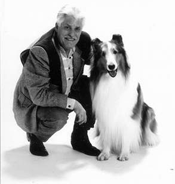
This photo of Bob and Laddie (the 9th generation Lassie) is in black and
white, like the TV show "Lassie" that ran for 20 years.
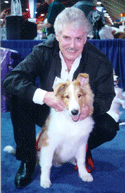
Today, Bob tends to Laddie (a direct descendant of the original Lassie, a
male collie named Pal) and Laddie's friend, a Skye terrier named Throttle.
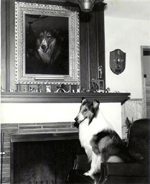
This is the original Lassie (real name Pal), beneath a portrait on velvet
done in 1950 by Warner Brothers scenic artist Don DeVanny.
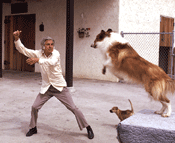
The legendary animal trainer Rudd Weatherwax Bob's father puts Lassie
through her paces.
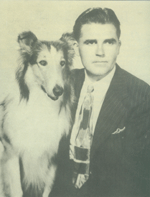
Early photo of Lassie and Rudd Weatherwax, who trained seven
generations
of Lassies up until his death in 1985. |